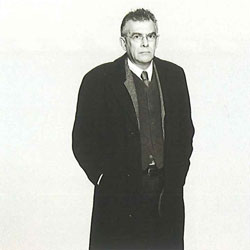Jorge Molder
Jorge MolderLisboa ¶ 1947
 |
|
| Créditos fotográficos / Photographic credits: Abílio Leitão |
His career as a photographer began with an individual exhibition in 1977, the subject of which was Vilarinho das Furnas (near the Gerês mountain range in Portugal) and in which what would be Molder's nostalgic inclination throughout his work was already present, accentuated by the use of black and white and the light sfumatto that only rarely is absent from his photographs. ¶ In 1980, he co-presented, with poets João Miguel Fernandes Jorge and Joaquim Manuel Magalhães, Uma Exposição (An Exhibition). In doing so, he made his first steps towards developing an interest in narrative strategies and a clearly cinematographic penchant in his work. In these first examples, the "film noir", under the auspices of Dashiell Hammett, are the aesthetic patina through which the abandoned places that Molder chooses as his backdrops can be seen. Such a cinematographic trait would only be reinforced when Molder implements the series as a structuring category of his work. In the whole of his artistic career, the series will become the most ubiquitous sense-producing mechanism, associated to a quasi-obsessive practice of self-portraits. ¶ In Joseph Conrad (1990) or The Secret Agent (1991), we can observe a progression of sceneries and props that might create the illusion of a suspended narrative, quite similarly to the clues scattered through a crime novel or a fantastic tale whose actual line of action is obscure. ¶ Although Jorge Molder took on self-portrayal as early as 1981, its current contours would only be filled up later. Presented also in series, his self-portraits have become an issue of self-representation, in which the "I" is revealed but also hidden from sight via the emergence of an "Other", that is, the protagonist of representation. ¶ In between the film noir and the Victorian novel, the secret agent and Mr. Hyde, the "Other" is the one who has broken free from his own body and acknowledges its own spectral condition, or in other words the condition of photography itself. As the ultimate confirmation of this condition, one must simply look at the series Nox (1999 Venice biennial), in which, in due course, the density of the blacks threatens to absorb the characters completely.
View the embedded image gallery online at:
http://www.cvc.instituto-camoes.pt/biografias-en/jorge-molder-95687.html#sigFreeIdf12c575fcf
http://www.cvc.instituto-camoes.pt/biografias-en/jorge-molder-95687.html#sigFreeIdf12c575fcf


